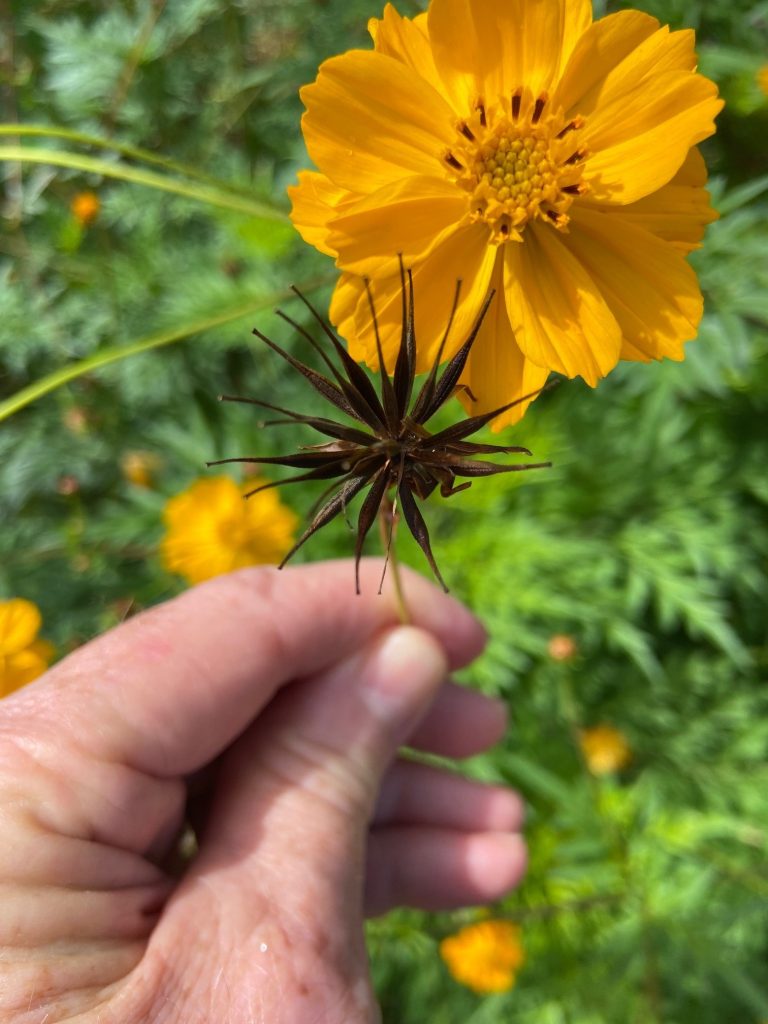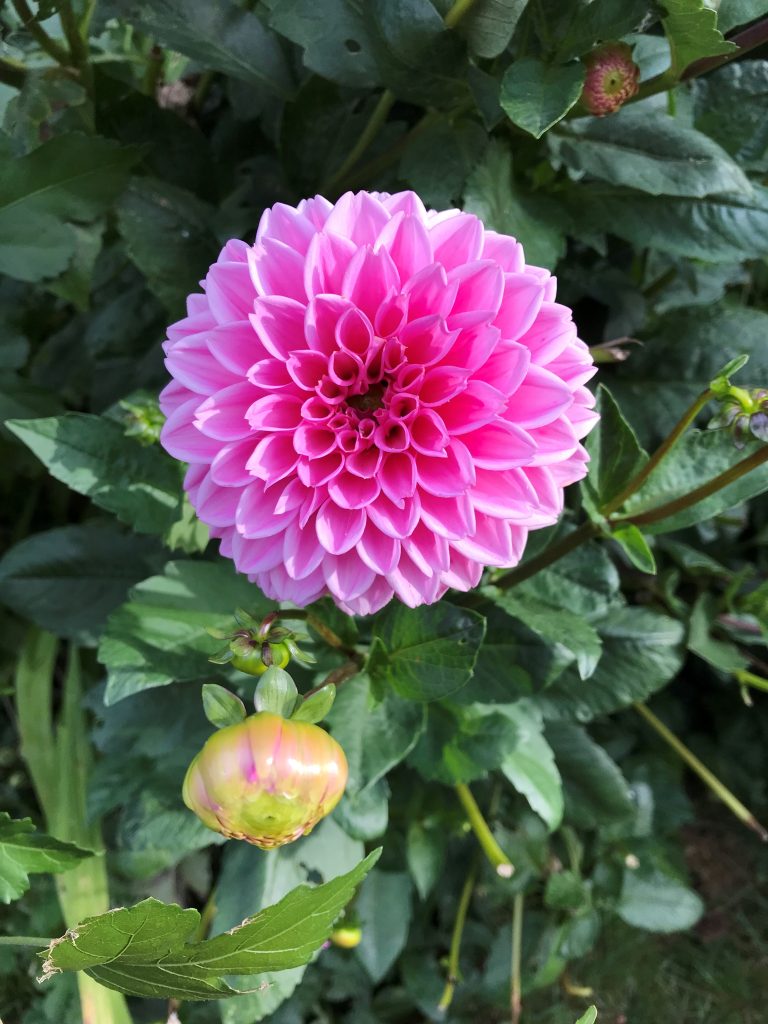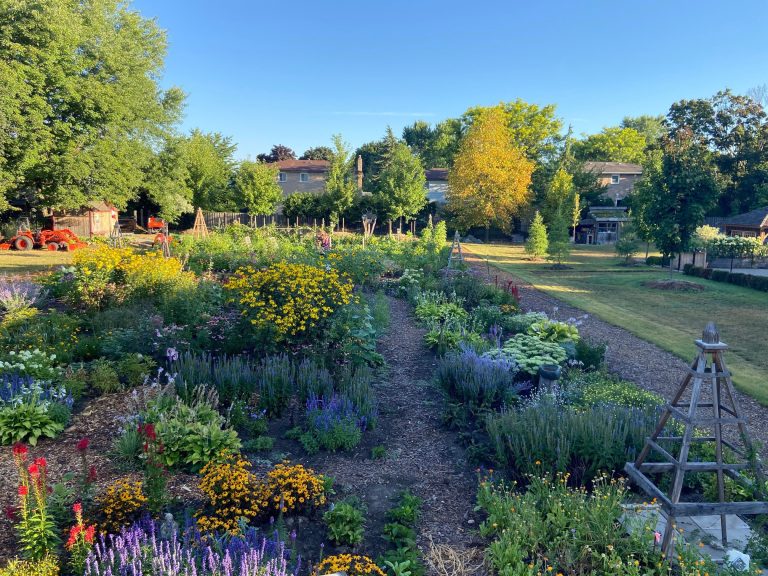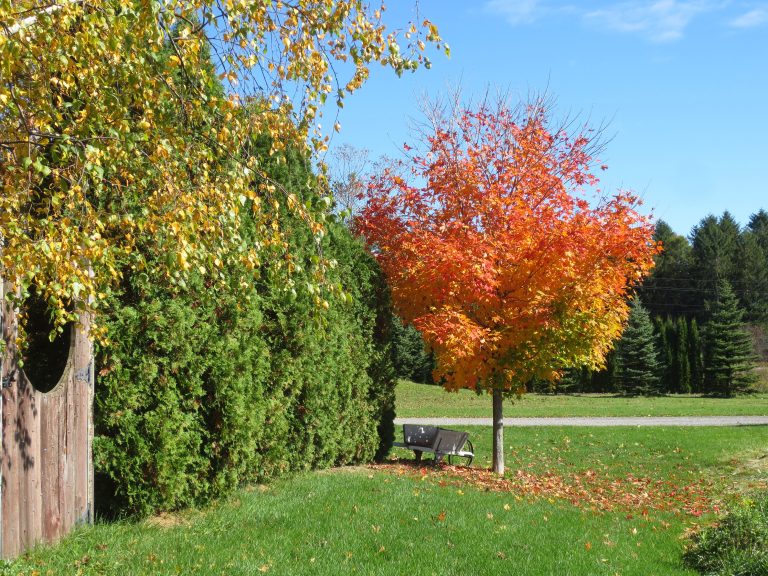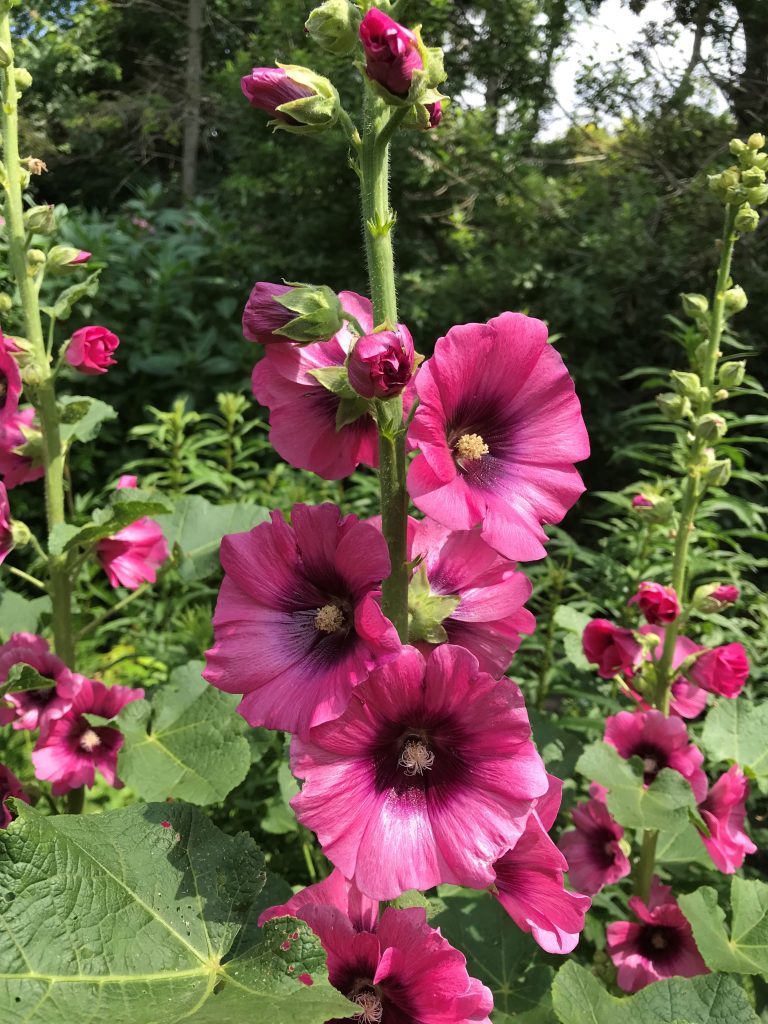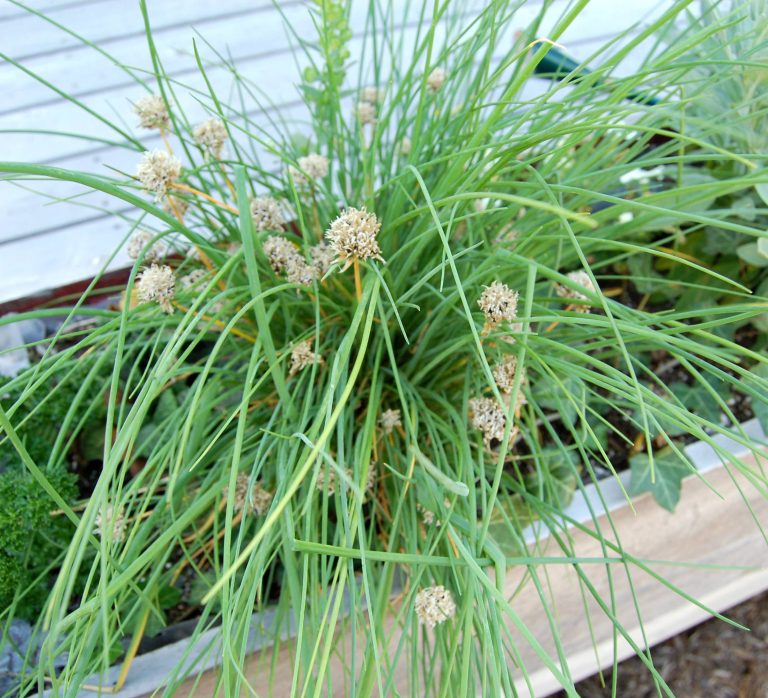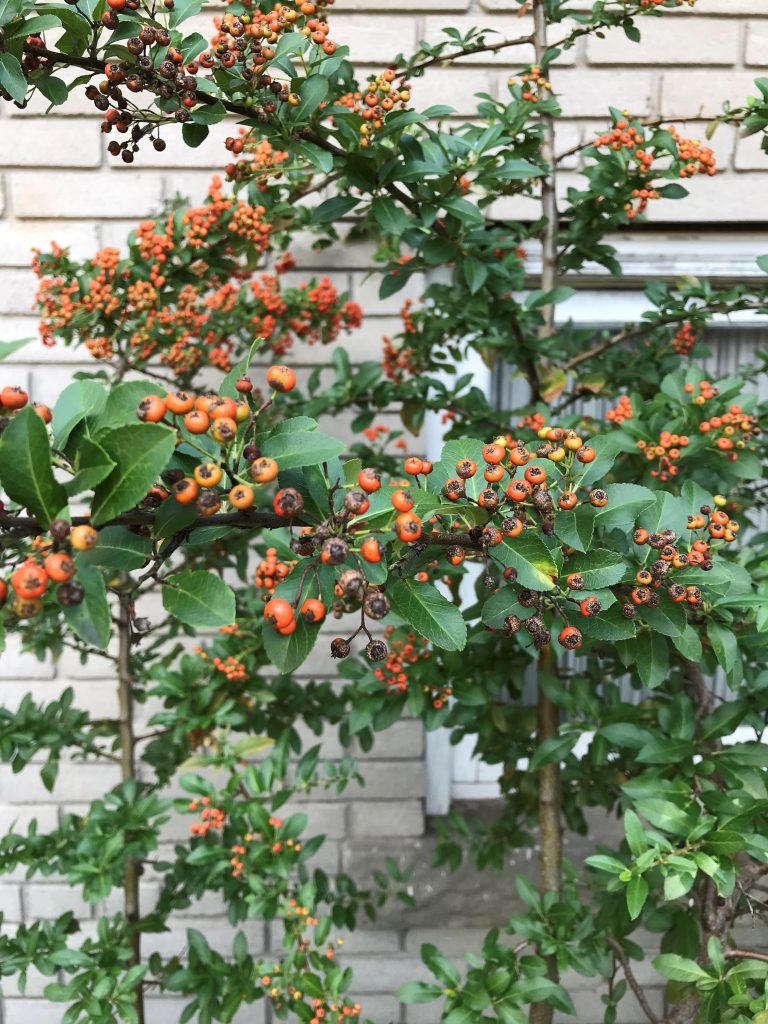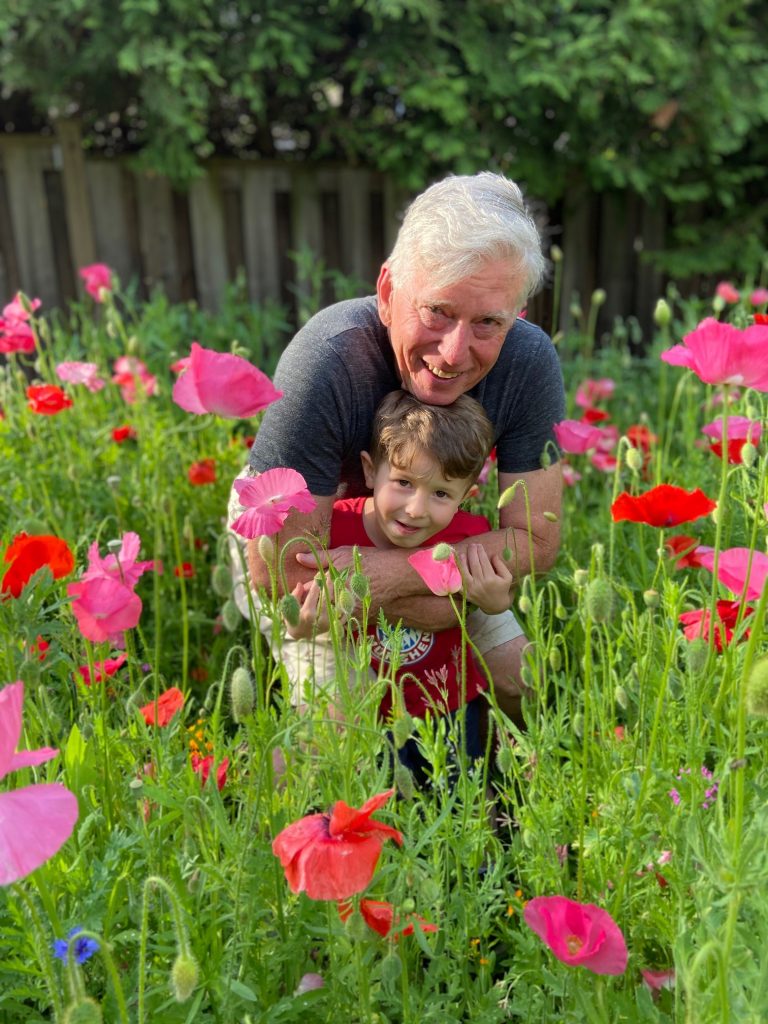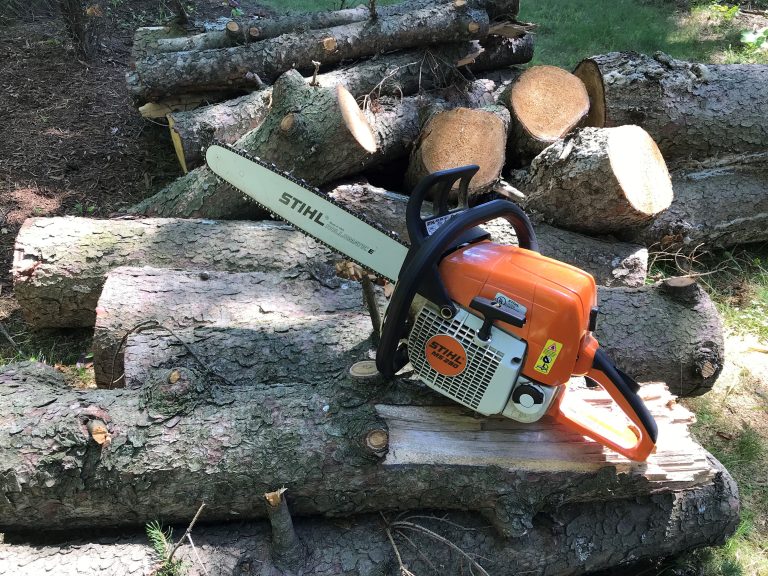Invasive species are on the radar like never before.
Not only are they as pervasive as ever in the natural environment, but there has also never been greater awareness in the gardening community. Overnight, it has become one of the top topics that we get questions about.
Invasive species are defined loosely as “…plants, animals and micro-organisms that have been accidentally or deliberately introduced into areas beyond their native range. Invasive species are introduced species whose introduction or spread negatively impacts the environment, economy, and/or society including human health” (Canadian Council on Invasive Species, HYPERLINK “https://canadainvasives.ca/invasive-species/” https://canadainvasives.ca/invasive-species/). As gardeners, we have a role to play in controlling the spread of invasive plant species.
Many gardeners would be surprised to find out common species that have been added to lists of invasives in recent years. Most plant species on the list were introduced intentionally, either for agricultural or ornamental cultivation and have escaped their intended homes. Many invasive plants are still available for sale in garden centers, as the industry struggles to keep up with new research on garden stalwarts. Climate change adds to the changing picture, as garden plants which were once contained by freezing winters are increasingly able to overwinter and spread year after year.
Here is a list of invasive species to look out for in your garden, and what to do when you find them:
• Common groundcovers such as periwinkle (Vinca minor), English ivy (Hedera helix) and goutweed (Aegopodium podagraria) were promoted to gardeners as alternatives to lawn or mulch until recently and are still available in many garden centers. Unfortunately, they started appearing in forests where they aggressively colonize the forest floor by crowding out native woodland plant species and smothering habitat. It is best not to plant these species to begin with, selecting a native ground cover such as running euonymus (Euonymus obovatus), bloodroot (Sanguinaria canadensis) or Pennsylvania sedge (Carex pensylvanica). To control invasive species, persistent removal is key and do not try to compost them or discard in a green bin program. Instead, dispose of them in a black plastic garbage back or consult with your municipality.
• Wintercreeper (Euonymus fortunei) commonly grown as shade tolerant, broad leafed evergreen shrub or vine. Wintercreeper is indeed winter hardy here in the GTA, but it is aggressive and can move into desirable naturalized woodlands. An alternative is Foamflower (Tiarella cordifolia), which Mark has grown in his deep shade garden with success.
• Daylily (Hemerocallis fulva). Many gardeners reading this column will be shocked to see the old fashioned, orange daylily on the invasive species list. The daylilies that grew at the base of your grandparents’ rural mailbox can spread by seed and root through ditches and waterways, providing a nuisance everywhere, pretty as they are for a day. Note that the many hybrids will not spread, generally have a clumping habit, and mature over several years into beautiful specimens. The brochure “Grow Me Instead” specifically mentions Hemerocallis fulva. HYPERLINK “https://www.ontarioinvasiveplants.ca/resources/grow-me-instead/” https://www.ontarioinvasiveplants.ca/resources/grow-me-instead/
• Black locust (Robinia pseudoacacia) was once widely planted throughout North America for its adaptability to disturbed sites, fast growing nature, and useful wood. However, in the natural environment, it is known to outcompete species at risk such as oak, beech-maple, and aspen. Young black locusts have leaflets along a 20-30cm stalk that can appear like a fern when young, though they grow into woody trees with sharp spines along the branches. In late spring they produce a white flower that gives way to pea-like seed pods. Traditional control methods such as simply cutting, girdling, and burning can promote suckering which ultimately encourages its spread. Start by preventing the spread by cutting, then smothering any remaining new growth with a plastic bag. We recommend that you plant suitable native species to jump start healthy redevelopment of the area.
To learn more and to find out what alternatives exist for replacing invasive plants, go to HYPERLINK “https://www.ontarioinvasiveplants.ca/resources/grow-me-instead/” https://www.ontarioinvasiveplants.ca/resources/grow-me-instead/
Mark Cullen is an expert gardener, author, broadcaster, tree advocate and Member of the Order of Canada. His son Ben is a fourth-generation urban gardener and graduate of University of Guelph and Dalhousie University in Halifax. Follow them at markcullen.com, @markcullengardening, and on Facebook.
Mark and Ben Cullen

Mark Cullen is an expert gardener, author, broadcaster, tree advocate and Member of the Order of Canada. His son Ben is a fourth-generation urban gardener and graduate of University of Guelph and Dalhousie University in Halifax. Follow them at markcullen.com, @markcullengardening, and on Facebook.
LATEST ARTICLES
Space invaders
The ins and outs seeds
Sometimes, life is just going to seed.
We think that can be a good thing. The life of a plant, in three words, is growth-flower-seed. This time of year, we are in a seedy place.
Where your vegetable and flower garden are concerned, you have an opportunity to harvest seeds to grow for next years’ garden. Here is what we recommend for best results:
Harvest seeds when they are brown and dry. If you cannot avoid harvesting when seed pods or seeds are wet, be sure to dry them thoroughly by placing them in a sunny window indoors for several days. Package them up in paper envelopes, labelled at the time of harvest (or you might forget what they are) and store in sealed containers like a mason jar. Drop a silica gel packet into the jar for a week or so to absorb any remaining moisture. Most pill bottles, or dry products in containers, contain silica gel. Save a few for this use.
Most seeds fall off the finished bloom to the ground or eaten by foraging songbirds. Some are best removed from their seed pod or husk by hand before they fall or get eaten. Marigolds, zinnias, sunflowers, hollyhocks, and calendula seeds are best harvested this way. Others, like poppies, can be harvested with a sharp shake of the pod, held upside down over a bowl.
Harvesting seeds:
The “low hanging fruit” are easy to harvest, store and germinate. These include beans, peas, nasturtiums, and corn, featuring large seed. Here are some other popular garden plants that produce seeds worth the harvest:
Lettuce plants bolt to seed this time of year. Wait for the puffy flower heads to dry on the plant and place the whole flower in a paper bag and shake to remove the hard, black seeds.
Basil produces tiny black seeds this time of year if you allow it to flower. Remove the spent flowers when dry and place in a colander or fine sieve. Gently rub them against the bottom of the sieve or colander until the tiny seeds are dislodged, into a bowl, preferably a white bowl that contrasts the colour of the seeds. Salvia seeds can be harvested in this way also.
Carrots and beets are biennial, meaning, they finish their growth cycle in the second year. Here in Canada, it is best to leave the plants to produce a flower this fall and stand over the winter. Some will produce flowers come spring. Allow the flowers to mature and go to seed, remove them and store for later sowing.
Tomato seeds are a bit tricky to retrieve and store, but worth the effort.
- Make sure you are harvesting seeds from an heirloom or heritage variety.
- Cut the tomato in half and squeeze the juice, gel, and seeds into a clean bowl.
- Pour three times as much water over the mess that you have created in the bowl. Mix it all up with your fingers. We find that it helps to pretend we are children while performing this task.
- Let stand for a few minutes and note that some seeds will have sunk in the liquid and others are floating. The sinkers are the winners that will produce plants come spring.
- Drain off the liquid and retrieve the sunken seeds, laying them out on paper toweling in a sunny window. Let dry for a week, then pick them off the towel, into paper envelopes, and place the envelopes in sealed containers.
The seeds that produce a new plant genetically the same as the “mother” plant, from which you removed the seeds, are heritage or heirloom, as long as the flowers were pollinated by the same variety. Hybrid plants can produce a wide variety of results, which can be fun but always unpredictable. The plant label will tell you if it is a hybrid.
The process of seed saving can be fun and satisfying. Next spring, you will save money by not having to buy seeds off the racks and today you will be reminded of the extraordinary cycle of life that exists in your garden.
Mark Cullen is an expert gardener, author, broadcaster, tree advocate and Member of the Order of Canada. His son Ben is a fourth-generation urban gardener and graduate of University of Guelph and Dalhousie University in Halifax. Follow them at markcullen.com, @markcullengardening, and on Facebook.
Tasks that require immediate attention
Have you ever sent a birthday card to someone after their birthday? A lot of us must have or there would not be so many greeting cards on the rack that apologize for our delay.
In the garden, there are deadlines that come and go, mostly unnoticed. Like bulb planting and growing a great looking lawn. What they have in common is that both tasks require our immediate attention.
Here are our top tips for both a great looking lawn and early spring flower garden, so you can enjoy a successful spring garden season relaxed and ready.
Lawn
If you want a guarantee that your efforts will produce the best-looking lawn, lay sod. In the remaining weeks of fall, sod will put down new roots and prepare itself for a long, Canadian winter. Grass is a cold season crop, which is why we do not recommend that you lay it mid summer. It is now a bit late to start grass seed as there is not enough time for it to germinate, put down root and anchor itself for the winter. If you do spread grass seed now, some of it will no doubt survive the winter and come up next spring.
Fertilize all grass, new and established, any time now using a slow release, fall formula.
Summer Bulbs
The plants that grow from a fleshy root, like dahlias, gladiolas, tuberous begonias, and canna lilies need to be removed from their containers or the ground where they were growing all season. Shake off loose soil, wash the roots of the giant tubers with a sharp blast of water from the end of a hose and allow to dry in the sun for a few days.
Store them in a craft paper leaf bag with clean straw or shredded newspaper for the winter. Place them in the coolest, darkest part of your house, but keep them frost free until later winter (for tuberous begonias) or early spring (for all but the gladiolas) when you will bring them upstairs and start them in the warmth of your living quarters. Gladiolas get planted directly in the garden soil in May.
Holland Bulbs
There are two reasons why you should plant Holland bulbs now, for spring colour.
- There is only shipment of bulbs that arrives at your retailer. Once they are gone, they are gone. Best get yours soon.
- Some bulbs need several weeks to put down roots before the hard frost of late fall. Daffodils, narcissus, and jonquils are in the “plant now” category. Tulips, frankly, are so indestructible that you can plant them as late you want (or can, given that hard ground frost will likely prevent you from digging the ground at all by late December).
Many bulbs fall into an “in between” category that can be planted later. Hyacinths, crocus, scilla, and many of the smaller bulbs will perform well next spring planted any time between now and early November.
When you plant spring flowering bulbs be sure that the ground is well drained. None enjoy wet feet. We recommend that you dig in generous quantities of compost and play sand to open clay-based soils. Clay is nutrient-rich, but the soil particles are so dense that water cannot move through it efficiently. The results can be rotten bulbs and a no-show come spring.
We do not recommend that you add fertilizer when you plant bulbs. Nutrients are packed into each bulb, enough to get it off to a good start come spring, unlike a seed with limited nutrient resources due to its size. This is part of the miracle that makes bulb growing so much fun.
If deer, squirrels, or other vermin enjoy eating or otherwise destroying your spring flowering bulbs, we recommend that you stick with the tried and true: daffodils, narcissus, and jonquils. They are mildly toxic and have a sharp taste that most problem pests will leave alone. Of course, we cannot speak for the squirrels that have a mind of their own. Squirrels have no rules.
A great looking lawn and garden starts by meeting this important deadline. Happy Thanksgiving.
Mark Cullen is an expert gardener, author, broadcaster, tree advocate and Member of the Order of Canada. His son Ben is a fourth-generation urban gardener and graduate of University of Guelph and Dalhousie University in Halifax. Follow them at markcullen.com, @markcullengardening, and on Facebook.
Nature based climate solutions
Another year of bizarre weather has climate change on the mind. Clearly, this is an all-hands-on-deck effort.
Whiz-bang technologies like carbon capture, electric cars, and plant-based meat substitutes grab headlines, but there is a whole category of solutions as old as time. They are referred to as “nature-based climate solutions”. These are loosely defined as working with, rather than against nature.
Nature-based climate solutions have countless add-on benefits which all relate to an improved natural environment, ranging from increased biodiversity to overall lower costs.
Gardeners can a lot to address climate change with nature-based solutions. Here are the top tips on our list:
- Plant native plants. Native plants originated here. They grew naturally, before the Europeans arrived about 500 years ago. They generally require less water, no winter protection, or insect and disease control. Perennials adjust to a warmer, drier climate by developing deeper root systems. They sequester more carbon into the soil. Native plants have the added benefit of supporting birds, insects, bees, and butterflies that coevolved with them, which increases biodiversity and resilience in the face of climate change. We recommend that you plant at least 70% of your garden in native species. https://nanps.org/ is a great resource for learning about plants native to North America.
- Plant densely. Mulch is a useful maintenance reducer in the gardening toolkit. However, think of living plants as a form of “green” mulch. They can do the heavy lifting in terms of sequestering carbon and supporting biodiversity. Fit as many in as possible in your garden space and they will naturally compete with weeds. Consider a native living ground cover such as barren strawberry (Waldsteinia fragarioides) or in a sunny, hot spot, broadleaf stone crop (Sedum spathulifolium).
- Plant a tree! The importance of trees cannot be overstated. Sometimes size really does matter, and a mature tree with its sprawling branches above ground and roots below ground simply make a greater impact on the climate than any other plant. A tree is of greatest value in the urban environment, where it can cool surrounding buildings and provide much-needed habitat for birds and insects, while improving air quality to the benefit of human health. The Canadian tree charity Trees for Life (of which Mark is a founding chair) estimates that planting 2 billion trees could remove 5,200,000,000 lbs of carbon dioxide from the atmosphere annually. https://www.treesforlife.ca/why-trees
- Stop fertilizing. David Wolfe, a professor of plant and soil ecology at Cornell University, found that for each pound of synthetic nitrogen fertilizer, 4 to 5 pounds of carbon dioxide are released (https://psci.princeton.edu/tips/2020/5/11/law-maintenance-and-climate-change). Instead use a non-organic fertilizer, spread one to two centimetres of compost to increase soil fertility either fall or spring.
- Focus on the soil. Soil stores carbon long-term. Basic soil structure is made up of clay, loam, sand, and organic matter which is alive with fungi, bacteria, and insects that dissolve minerals and mobilize nutrients throughout the soil to support plant life. Pesticides often kill these beneficial communities, where overwatering can also deprive them of necessary oxygen. Rototilling destroys soil structure and releases soil carbon and nitrogen into the atmosphere in the process. Soils should be fed with natural fertilizers such as compost and disturbed as little as possible. When the leaves fall from your neighbourhood trees, leave them on top of your garden soil, but rake them off your lawn.
- Go Electric. This is whiz-bang technology. Not creating emissions in the first place is key. If you already have a cordless electric drill, check to see if the manufacturer is making compatible outdoor implements such as lawnmowers and pruners which can use the rechargeable batteries you already have. Ben recently found this to be the case with his Makita drill battery, which can power a range of outdoor power equipment by the same brand, meaning fewer batteries to be made, and a lower price for new implements.
As gardeners and stewards, it feels great to be part of the nature-based solution.
Mark Cullen is an expert gardener, author, broadcaster, tree advocate, and Member of the Order of Canada. His son Ben is a fourth-generation urban gardener and graduate of University of Guelph and Dalhousie University in Halifax. Follow them at markcullen.com, @markcullengardening, and on Facebook.
5 Steps to the Best Fall Garden Ever
There are many activities that we can enjoy this time of year in the garden that will pay big dividends later in the season, next spring and even for years to come. Here are our top 5 tips to make the most of your fall garden:
- Colour. Ontario is world famous for fall colour. While nothing substitutes for a trip up north to see the changing leaves of Algonquin park, you have an opportunity to create a show in your own yard or balcony by planting trees and shrubs that show off each fall. A short list of the best, brightest stars in the leaf-colour category that you can plant now:
Native Canadian sumac, brilliant red, early in the season. Birds like the fruit too.
Canadian Larch, another native, only this one is “deciduous evergreen”. Has the look of an evergreen but drops its foliage late each fall, in mid November. A great farewell to a fine growing season. Very winter hardy. Grows to 15 metres.
Sugar Maple. The maple that produces maple sugar-sap come spring also produces the best fall show of colour of all maples. Sometimes red-orange, other times yellow. Always beautiful. Other deciduous (trees with leaves, vs. needles) that provide a great fall show include red and white oaks, which turn red this time of year. They derive their name from the colour of their wood. Little leaf lindens and native basswood, which are related, turn brilliant yellow. Beech trees, both European and native Canadians, turn yellow later in the season.
- Colour. Not leaf colour, but flowers that look fabulous in your garden now through hard frost. Our #1 pick are New England Asters, which are native here, not just in New England, and produce abundant blue or purple flowers each fall. Reliable perennials.
Chrysanthemums. There are so many “Mums” available for sale at retailers this time of year that it seems redundant to suggest that you plant a few. At the front door, in containers, in the garden outside the back door. Wherever you would like to see unstoppable colour. Not reliably winter hardy, but worth the investment just the same.
Flowering cabbage and kale are flowering plants that improve with frost. Imagine colour that peaks mid November! Not edible, though, we wish.
Rudbeckia. The yellow flowering “Black Eyed Susan” has been showing off since late August. They have more gas in their flower tank than any fall blooming plant we know.
- Start or thicken a lawn. This is the best time of year to spread grass seed to thicken an established lawn, start a new one or lay fresh sod. We highly recommend that you spread a couple of centimetres of triple mix or compost, broadcast quality grass seed, rake smooth and water. Stand back and watch the miracle happen. But hurry, this works best when done by the end of September. No need to fertilize until late October or November.
- Compost. The zucchini plants delivered their bounty some weeks ago and now they are dried up and the leaves yellow. Dig them up and toss in your compost bin or pile. Let them rot there. Same with finished annuals and other vegetable plants that have produced and are now in decline. The frost will break down any green, living tissue in the plant and they will become mostly water, with the remains providing nutrients for the compost and eventually for your garden, that is, when you spread the finished material on your garden next spring.
- Feed the birds. Many bird species are returning from their happy mating grounds in the Boreal Forest where they hatched a family and brooded their new young. Many are on their way south for the winter. As they prepare for that long trip, especially across Lake Ontario, they consume a lot of food to “beef up” for the trip. This is a great time of year to feed hungry birds including hummingbirds, which linger here until the first killing frost.
Fall is for gardening. Enjoy these shortcuts to the best fall garden ever, with added benefit next season.
Mark Cullen is an expert gardener, author, broadcaster, tree advocate and Member of the Order of Canada. His son Ben is a fourth-generation urban gardener and graduate of University of Guelph and Dalhousie University in Halifax. Follow them at markcullen.com, @markcullengardening, and on Facebook.
Gardening for People with a Short Attention Span
Our patience for long stories seems to be short. Thank you, Twitter, for reminding us that many people have a maximum 280-character appetite for stories. In this respect, we are thankful that our readers have the patience for depth.
Gardeners are people too and maybe some of you would like to tighten up your gardens’ performance, get more bang for the buck, more colour, pollinator activity more often. Sparklers and star bursts that go higher, longer, brighter.
We can help you with that. We have created this plan for people who want to see more change, more often in their garden. The kind of change that holds your attention.
- Start early. Plan to plant now for the earliest possible horticultural show come spring. Dutch bulbs have arrived at your favourite garden retailer, and we urge you to get in and buy up the best stock while the selection is at its best. We guarantee that the snowdrops, which literally push up through the March snow, will give you a thrill greater than the fat rhododendron with full-bodied blooms come mid May. Why? Winter is long, and we are starving for natural colour, a word from nature and for life outside our back door. Other early performers include crocus, narcissus, and blue scilla. Plant spring flowering bulbs now.
- Succession blooming. A garden is a work of art that is ever changing. Except in winter, perhaps. For proof, try and walk through your garden slowly every day. In time, you will see that there are no two days the same. Plants grow, flower, produce seeds and do not stop until the hard frost of November puts a temporary stop to the action. We recommend that you study the plants that catch your eye while in bloom. Consider what you like to see in spring, summer and fall. Walk your neighbourhood, join a local horticultural society, go online, visit our website www.markcullen.com, join a gardening Facebook group and talk to your neighbours – they might even be willing to split what they have with you.
- Fireworks. If you like plants that go “bingo!” when they bloom, look for the following favourites:
- Eastern Redbud (Cercis canadensis). It’s hard to believe this beauty is native to our land. Redbud trees flower on old and new wood, creating a multi dimensional linear spectacle of plugged in, rose red blossoms in early May. We can not describe any other flowering plant this way as there isn’t one.
- Hollyhocks (Alcea rosea). An amazing show off with a pedigree. Early settlers in Canada grew hollyhock from seed (easy to transport) for reliable colour on long stems, up to two metres in height. The biannual plants produce seeds that fall into the garden and often germinate there, producing colour two years later. Like a shooting star, they can bloom on the tip of the flower stem while dropping seed from earlier blooms at the bottom of the same stem. Sun.
- Blazing Star (Liatris spicata). A native, amazing upright, shooting star of purple, magenta or blue that attracts pollinating bees. Grow from bulbs or as perennial plants. Grows to 40 cm. Full sun.
- Delphiniums (Delphinium elatum). Much like hollyhocks, they steal the show come mid summer with scarlet, purple, pink, blue or white blossoms that march up a stem about two metres high. When they are in bloom it is hard to notice anything else in the garden. They are the child in the family that attracts all the attention when they are in the room.
- Rose of Sharon (Hibiscus syriacus). In bloom now in a garden near you. You can not help but notice them as they produce striking bicoloured, double blossoms on sturdy stems, up to three metres high and two metres wide. Bloom for several weeks, up to three months. Perfect for the impatient, demanding gardener.
In the garden and on the reading list, there is a time for depth and a time for action. Take time to indulge in both.
Mark Cullen is an expert gardener, author, broadcaster, tree advocate and Member of the Order of Canada. His son Ben is a fourth-generation urban gardener and graduate of University of Guelph and Dalhousie University in Halifax. Follow them at markcullen.com, @markcullengardening, and on Facebook.
Year-round herbs
Cooking is a year-round endeavour, like eating.
Gardening on the other hand, gets interrupted by winter. This time of year, we busy ourselves harvesting and preserving the many goodies that our gardens produce like seeds, fruits, vegetables, and herbs.
We often overlook the opportunity to plant food crops that survive our winters nicely and return in spring. Like perennial herbs.
The herbs that you plant or sow from seed now produce a much greater abundance next spring than the same species planted after the snow melts. The few weeks that remain in the current season encourage new roots and a more established plant.
The results are amazing come next season.
Here is our list of favourite perennial kitchen herbs that we recommend for planting now:
Chives. Allium schoenoprasum. The native, perennial onion flavoured plant is one of the easiest plants to grow if you have 5 hours of sun or more in your garden or container. Very winter hardy, the dark green, hollow spears poke up through the soil in April and grow like crazy for several months. The best stems for preparing for the table are the young, tender ones. Encourage them all season long by harvesting often and cutting the green leaves low to the plant. Bees love chive flowers. They transplant well and should be divided every three to five years. Mark found his current crop of chives sitting on top of a compost heap at the allotment gardens at the Leslie Street spit, they are that easy to grow.
Dill. Anethum graveolens. Made famous by the pickle, dill has more uses than jarring the seeds up with cucumbers. Feathery dill leaves add flavour to salads and soups. Dill seeds perk up bread and salad dressing. The plants grow two to three feet tall in the sun. It is a hardy annual plant. Let it go to seed in your garden you will enjoy having it most everywhere next season.
Mint. Mentha. Much like dill, when you plant mint, you have created a marriage with it that is very difficult to divorce. Peppermint, spearmint, apple mint, cat mint, to name a few, are all useful in the kitchen and in drinks. Cut stalks now near the bottom of the stem and hang upside down for ten to fourteen days. Bees love all mint while in flower. Sun or part shade.
Oregano. Origanum vulgare. Italian cooking often features this tasty herb, which grows to about 25 or 30 cm tall in a sunny garden. We often plant it in containers where it falls over the edge to create the impression that we are so good at growing plants some try to escape. Dry oregano by cutting the stems 2 cm from the bottom, preferably before the flowers open. Hang to dry in a warm, shaded place for about two weeks.
Sage. Salvia officinalis. Known for its healing properties, its use in the kitchen extends to flavouring meats, stuffings and bean stews. Use just a few leaves the first year, taking more as the plant matures over years. After it gets established, sage takes long periods of drought. Grows to 20 or 30 cm high, loves the sun. Sage smudging ceremonies are common in many Indigenous cultures and are used to cleanse the past, popular at weddings. Sounds like sage advice to us.
Thyme. Thymus vulgaris. Choose from lemon, creeping and common thyme. This plant has been hybridized to create a variety of purple, red, and bronze flowering varieties, mostly in the genre of “creeping” thyme, a substitute for lawns that is growing in popularity. While in bloom, bees love all thyme. Use fresh or harvest leaves this time of year and hang to dry in small bunches. Kitchen use includes turkey stuffing and soups. We would tell you more, but we have run out… of thyme.
Two elements of growing culinary herbs that almost all have in common is an appealing scent and resistance to insects and disease. Rub your fingers through the foliage of most herbs to release the flavourful oils and inhale the savoury aroma.
Mark Cullen is an expert gardener, author, broadcaster, tree advocate and Member of the Order of Canada. His son Ben is a fourth-generation urban gardener and graduate of University of Guelph and Dalhousie University in Halifax. Follow them at markcullen.com, @markcullengardening, and on Facebook.
Plants That Say “Go Away”
Some plants are the kickboxers of the plant world. They arm themselves with a sharp defence we generally refer to as thorns.
Planting thorny shrubs and trees around your house does not have to be entirely negative, merely a suggestion to anyone wanting to cut the corner of your property to get somewhere quickly, or to encourage foot traffic in another direction.
Make your point with this list of thorny vines and shrubs:
Hawthorn (Crataegus spp.) is a genus of trees and shrubs which include many species native to Ontario. Canadian Hawthorn (Crataegus canadensis) is a native tree that grows up to 10 metres in a wide variety of soil types. It flowers in early summer and produces berries (“haws”) which are popular with birds but generally mealy for human consumption. Besides, who wants to harvest from a thorny tree?
Brambles such raspberries and blackberries, speaking of harvest. Raspberries have dense, small thorns which appear like fuzz but anybody who has crossed them will tell you: they hurt. Blackberries tend to have singular, conspicuous thorns that will snag and prick with a slight hook that seems to reach out and grab you. Best planted in moist, fertile, and well drained soils during early spring and maintained by pruning old fruiting canes to the ground after harvest each year. Wear thick leather gloves for the job. A dense thicket of berries along the property line is sure to stop anyone in their tracks, even if they simply stop to enjoy your berries from the other side.
Firethorn (Pyracantha spp.) is marginally hardy in zone 5, which would therefore do best in a protected area with lots of sunlight. White flowers become yellow, orange, or red berries with green foliage and large thorns. While commonly planted as a barrier shrub, it can also be trained to an espalier or trellis. Mark grew up with Firethorn (well named) growing on his childhood house over the garage wall. He learned the hard way not to fall into it.
Roses are an obvious option, so broad and diverse we could devote an entire column. A climbing rose such as Rosa ‘Alexander Mackenzie’ can be trained up a trellis or fence to act as a flowering deterrent to unwanted foot traffic. Rugosa roses are the parent of many shrub roses which have a long flowering period from early summer to first frost and each stem is covered in very sharp thorns. Attractive to pollinating insects and butterflies, the flowers give way to rosehips which are devoured by birds throughout the winter or can be used for jams and jellies. Resistant to heavy pruning, fit the mature size of the rose bush to the space you wish to fill.
Hollies (Ilex spp.) A diverse genus, with some native varieties to Ontario such as Ilex verticillata or Winterberry which does not have thorns. Ilex aquifolium, or English holly, has red berries and glossy evergreen leaves which come to a prickly point. Available in easy to manage dwarf varieties, you can prune your holly and berries for plentiful Christmas décor.
Black Locust (Robinia pseudoacacia) is a native tree to Ontario which produces branched thorns on its trunk and limbs up to 30cm (12in) long. Maturing into a large shade tree, the seeds and seed pods have a honey and castor-oil like taste which gives the tree its name, and are attractive to deer, squirrels, and quail. Is it a tree or a weapon?
Japanese Barberry (Berberis thunbergii). A versatile, low growing shrub that was once a popular choice for hedging, now used as an accent plant in any sunny garden. Each bush is loaded with needle sharp, short thorns that would discourage any burglar not dressed in leather motorcycle gear. Look for green or red barberry. Hardy to zone 3 (Regina).
Note that special gloves have been designed that withstand the prickly nature of most plant-born thorns. They are expensive but worth it. Mark has three pairs, want one?
Enjoy a garden that provides food, shade, colour, and a touch of self-defense.
Mark Cullen is an expert gardener, author, broadcaster, tree advocate and Member of the Order of Canada. His son Ben is a fourth-generation urban gardener and graduate of University of Guelph and Dalhousie University in Halifax. Follow them at markcullen.com, @markcullengardening, and on Facebook.
A “Not-To-Do List”
Tired of being told what to do?
If so, you will like our column this week. Gardeners are generally busy doing stuff. But there are some tasks that just are not necessary, some are a walk backwards.
Here is our list of Not To-Do’s which will guide you to your most productive garden outcome:
Fertilizing. Resist. Do not fertilize your permanent plants in the second half of the season, ie. now. Most plants will have taken what they need from the soil and an additional boost of nutrients can result in soft new growth that is susceptible to winter dieback. Focus on long-term soil fertility by adding compost and mulching heavily for happy, healthy plants come fall. Note that tender annuals can be fertilized any time all season long as they die with first season frost anyway.
A fall lawn fertilizer, which is important, should be lower in nitrogen (which promotes green growth) and relatively higher in phosphorus (to promote healthy roots) and should not be applied until late October or early November.
Scheduled watering makes no sense. You drink when you’re thirsty, right? Plants are like people, which is why putting your in-ground sprinkler on a timer is a waste of water and may lead to over watering. Apply water less frequently, and deeper to train your plants to put down deeper roots. Note that perennial plants all have different needs for water. Astilbe does not like to dehydrate while Hosta are tough as nails in this regard. Hand watering has its advantages.
Do not garden naked. We have tried weeding in flip flops, and it never goes well. We wear cloths in the garden for protection: from the sun, prickles, soil, and stinging nettles (do not think too much about this, but stinging nettles while gardening naked?). Americans in Seattle have other ideas. They created a day called World Garden Naked Day, which is always the first Saturday in May. The British have enthusiastically embraced this idea. Pruning while naked? Strictly forbidden.
Landscape fabric. Sometimes called weed barrier fabric. We believe that this is false advertising. When you lay down the polyester spun material that allows water through and in theory no weeds, you are inviting weeds to germinate and root into the fabric, which is course and tough as nails. The results are not weedless gardens but gardens full of weeds that are difficult to pull out of the ‘weed barrier’ fabric. It IS useful for use under interlocking brick and to line a retaining wall, holding back excess soil and grit.
Cut your lawn. Of course, you will cut your lawn when it is needed, but when is it needed? We say, not until it grows above 7 or 8 cm tall. The taller the grass blades the deeper the roots. Most Canadians cut their lawn too often and too short.
Do not forget the garden furniture. You placed a bench in the extreme end of the garden as it looks good there. When did you last sit on it? Shut your eyes and listen to the wind in the trees, the bird song in the bushes, the buzz of bumblebees in your bergamot? There is so much more activity going on in your garden than you will ever realize, until you stop long enough to observe it with all your senses.
What not to do in the garden? Work. We do not mean ever, but from time to time, work is done even when there are endless jobs still to do.
Here’s a recommendation: Mark sowed a garden of “hummingbird flowers” in his yard with his four-year-old grandson Conrad last fall (McKenzie Hummingbird and Wildflower mix, $14.99). This year it exploded with poppies and a variety of other bright, pollinator-attracting flowers. When you stand next to it, as Conrad does every time he visits, you slowly become aware of the myriad of mason bees, bumble bees, unidentified flying objects and yes, even hummingbirds that are a cinch to overlook while you are in motion.
Mark Cullen is an expert gardener, author, broadcaster, tree advocate and Member of the Order of Canada. His son Ben is a fourth-generation urban gardener and graduate of University of Guelph and Dalhousie University in Halifax. Follow them at markcullen.com, @markcullengardening, and on Facebook.
The right tools for pruning
Last week, we discussed the importance of late summer pruning of trees, shrubs, evergreens, and perennial plants. But what tools are best for each job? Herein, your answers, from the smallest to the largest pruning jobs:
Hand pruning. Light pruning is best performed using a sharp, quality pair of hand pruners. These are light and useful for removing growth up to a centimetre in diameter, or about the thickness of your baby finger. Make sure your hand pruners are sharpened every time you use them, clean and lubricated with general purpose oil.
Loppers are large “hand pruners” that work on the same scissoring principle, using either bypass or anvil type cutting blades. The main difference is that loppers have long handles, sometimes with extensions that help you reach up to a metre into a tree or shrub to cut out mature woody stems. The long handles and heavier blades of loppers make cutting green branches up to 2.5 centimetres or an inch in diameter easy.
A pruning saw is different from any saw. Unlike the crosscut and rip saw, a pruning saw cuts on both the fore stroke and back stroke, cutting the work required to do the job in half. Unlike your camp saw, used for cutting small branches for building a campfire, a pruning saw is designed to cut green wood. You will find the difference striking. And the work of using a good, sharp pruning saw a joy compared to anything else.
Chain saw. Unless you have been trained on the proper and safe use of a chain saw, we recommend that you skip this. Removing one of your own limbs is never the idea behind a good pruning job. There are now some excellent rechargeable long handled chain saws that are light and relatively easy to use. Stihl makes an excellent rechargeable model. After all if the chain is several feet away from you, what can go wrong? Well, a limb might fall on your head. Which is another reason why signing up for a chain saw course, as Mark did, is a good idea. Landscape Ontario has an excellent one at https://horttrades.com/training.
Your pruning equipment does not end with the cutting tool. Here is a list of the other essentials to ensure a safe, effective job:
Heavy gloves. Say you miss cutting the limb of a tree and cut your finger instead. Do not laugh. Heavy leather gloves help to protect fingers and hands. If your gloves have a long cuff to protect your wrist and forearm, so much the better.
Goggles. Such an obvious choice. The saw dust created from limb removal overhead is one hazard to your eyes. So are the small branches of shrubs and trees as you reach into the plant to access the limb you wish to remove. Often, we just don’t see that little stem coming at us.
Long sleeves. Remember your forearm and wrist? Wearing a long-sleeved shirt is an especially good idea if you are working with evergreens like spruce or junipers, which have prickly foliage. Exposed forearms that contact junipers often suffer from “juniper rash”.
Steel toed boots. For all the limbs that crash to the ground from somewhere up in a tree, there is the potential for toe injury. Not to mention tripping on the roots of mature shrubs and trees while your attention is focused on the limbs above your head. Steel toed boots provide a level of confidence for the wearer that is hard to describe, and they aren’t always as clunky as the construction boots you likely have in mind. We like Blundstones. Let’s put it this way: when you know that the potential for personal injury is minimized, your confidence level goes up. You make smarter choices. Leave the flip flops on the deck.
If all of this sounds a little obvious, we give you credit for your risk-awareness. Unlike the rest of us, for whom this reminder can be very useful.
Mark Cullen is an expert gardener, author, broadcaster, tree advocate and Member of the Order of Canada. His son Ben is a fourth-generation urban gardener and graduate of University of Guelph and Dalhousie University in Halifax. Follow them at markcullen.com, @markcullengardening, and on Facebook.


